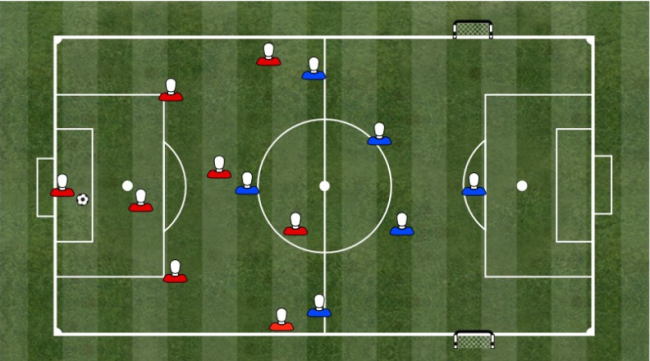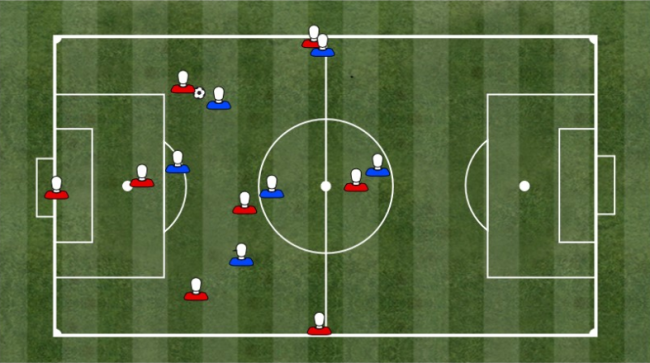Getting your side to develop their tactical understanding without the luxuries afforded to professional and academy sides can, and for myself, did pose a significant challenge. Not only instructing the style of football you want to play, but also coaching the basic principles which unfortunately, players do not receive significant exposure to in grassroots coaching. In essence, this article looks at how you can get your players to be “match ready” for both the tactical demands of football and the tactical style you wish to impose upon the team. If you can develop this effectively, then you can gain a greater understanding of the technical, physical and even psychological limitations of your players.
myself, did pose a significant challenge. Not only instructing the style of football you want to play, but also coaching the basic principles which unfortunately, players do not receive significant exposure to in grassroots coaching. In essence, this article looks at how you can get your players to be “match ready” for both the tactical demands of football and the tactical style you wish to impose upon the team. If you can develop this effectively, then you can gain a greater understanding of the technical, physical and even psychological limitations of your players.
For clarity, I will provide an example. You may have midfield player who is often losing the ball or being caught in possession. It may seem an obvious solution to say that they are not quick enough on the ball or that they hold on to it for too long. However, if this player does not adequately understand how to create or exploit space and their teammates are not doing the same, then it is likely that they will often be receiving the ball in very condensed areas of the pitch with little options in terms of releasing the ball. Similarly, penetration demands intelligent off the ball movement, unbalancing a defence may require switching of play which in turn requires width and depth. You will struggle to find a non-tactical aspect of the game which is not aided by the tactical understanding of your team. So the question is, how can we achieve this with potentially inconsistent numbers of players arriving to training, without the aids of video footage and tactics boards and often with one, perhaps two coaches? The session I have taken to using is quite simple and hopefully is something which can be used to by others looking to develop their teams tactical knowledge. I set up two teams, a defence (red) and an attack (blue), usually giving an overload to the defensive team.
 The defensive team must play out and either dribble into the three goalmouths or score a close range goal in them, while the attacking team simply have to score against the goalkeeper. In the example above I have used the 3-4-3 formation we play with for the defensive team, so if we had more players I would add a striker or give the attacking team two wide players to allow the three forwards to stay more narrow. This is very flexible and can be transferred to fit any formation. The attacking team will use the front 3 system we play with and have 3 central midfield players who will have to adapt to playing the wing back/centre back roles where necessary. Once the session is under way, it allows you to go in and coach the game individually while the session continues or coach the entire group where necessary. When coaching the session, if I need to talk to one or two players alone, then I simply pull them out to one side and let the game continue. It will force players to cover positions and provides another element to the training which perhaps is not addressed frequently enough. To follow are the two key areas I look to address and how I to do this.
The defensive team must play out and either dribble into the three goalmouths or score a close range goal in them, while the attacking team simply have to score against the goalkeeper. In the example above I have used the 3-4-3 formation we play with for the defensive team, so if we had more players I would add a striker or give the attacking team two wide players to allow the three forwards to stay more narrow. This is very flexible and can be transferred to fit any formation. The attacking team will use the front 3 system we play with and have 3 central midfield players who will have to adapt to playing the wing back/centre back roles where necessary. Once the session is under way, it allows you to go in and coach the game individually while the session continues or coach the entire group where necessary. When coaching the session, if I need to talk to one or two players alone, then I simply pull them out to one side and let the game continue. It will force players to cover positions and provides another element to the training which perhaps is not addressed frequently enough. To follow are the two key areas I look to address and how I to do this.
1. Width a depth. The first thing I will always do in this session is ensure that the team in possession has both width a depth and that the team out of possession is compact in the danger zone. As you can see with the red team on the left half of the pitch, the wide players are out on the touchline, as wide as they can possibly get. Furthermore, through the movement of the full backs to a high position, it gives the team depth (obviously in a match situation you would have players further up the pitch, but this allows the full backs to get into the habit of getting high and wide). This width and depth opens up the pitch, allowing more space to play and receive the ball. It also opens up gaps between opposition players and can begin to destroy defensive cover, increasing the opportunities for penetration. I often find that the wide players want to come inside to get more involved with the game, which compact’s the playing area and makes attacking more difficult. The solution here many not be to force certain players to stay wide, but to ensure that the whole team understands the need for width so that if the wide player does move into a more central position, another can adjust to provide the width. On the right hand side we see an example whereby the red team are narrow and compact, reducing options and giving little space in the dangerous areas. In the 3-4-3 formation, the two wing backs drop in to more central positions, while the centre midfielders try to deny any space in front of the defence. Compactness will be discussed further in the next section.
 Left: Red team in possession stretching the pitch. Right: As blue team attack, red team compresses playing area.
Left: Red team in possession stretching the pitch. Right: As blue team attack, red team compresses playing area.
2. Pressing. Unless they have been coached otherwise, players will tend to press the ball on their own. Little thought will be given to doing this as a unit and subsequently you end up having players chasing those in possession around until they get tired, frustrated or both. This is something I chose to address early on in the process and have subsequently held training sessions dedicated entirely to it. If players press on their own, then the team in possession can simply pass through the defending team with little difficulty and very quickly defensive shape is lost. This opens up spaces between defenders and so provides opportunities to penetrate. What I encourage is that first and foremost, the team recovers into a solid and compact,defensive shape.

The diagram above shows the blue team dropping off to deny opportunities for the red team to move the ball forward. The player in possession can chose to go back to the central defender/goalkeeper or switch play to the right flank. This is a comfortable position for the blue team and it has been achieved by remaining compact and looking to both mark players and block potential passing opportunities. Once you have a team that uses this as default, then it becomes easier to coach pressing. From the picture above, all it takes now is a few adjustments to put the red team under considerable pressure.
From just a few movements, the red team has been given a serious problem. The only viable option is now to try and beat a man or play back to the keeper, and even this pass is under pressure. An easy way to coach this is to stop the game, make the adjustments to player positions and then ask the team with the ball to try and play out. I am particularly fond of this, because it shows that you can press effectively with a 2 player disadvantage and it forces the team in possession to be creative. If they struggle with this, changing it to a 4v4 game can help, as it really highlights how quickly you can remove any options and if you have two groups, it allows them to experiments with pressing without the pressure of being watched by the coach.
I feel that once you have these two key concepts in place, you can really begin to test your players and your tactical interventions will be required, not just given because you want them to learn. With a well organised defence and pressure on play realistic to the game, you can now work on ways of breaking it down; switching play, overlapping, positional rotation and so on. Furthermore, the technical elements of practice can now be tested and assessed in a more game-realistic scenario. The potential of this session is such that I can use it as an assessment model for the progress of the team in almost every aspect and subsequently plan future sessions based upon it. In addition to this, it allows the opportunity to practice the tactics which will be used on match days.
While this session may need to be scaled down for the younger age groups, I feel it can be used with all ages and abilities, provided you are forgiving with the rate at which you feed information. It allows you to go in and coach the minute details of the game, whilst also allowing you to freeze practice and show the players how they fit into the bigger picture. I will follow up this article looking at progressions from this stage, but hopefully this can be used a starting block for tactical development which also allows for match day tactics to be implemented.
The second part in this series can be found here.

6 thoughts on “Tactical Development for Grassroots Football; A Simple Tool for Training”